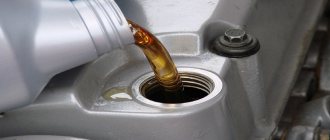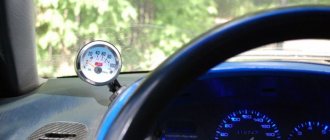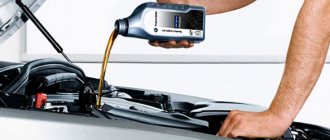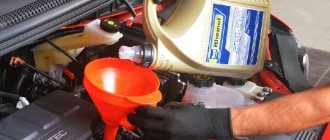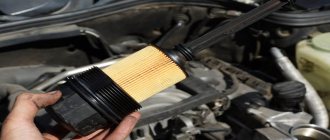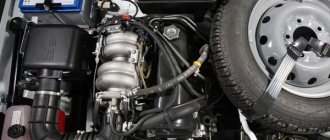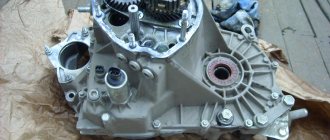As a rule, novice motorists encounter the first difficulties when servicing an internal combustion engine precisely when it comes to the lubrication system. The fact is that many drivers know well where the oil is in the engine, but not everyone knows what the engine oil level should be and how to accurately check it.
No less difficult is the selection of oil, as well as the determination of its replacement intervals. In this article we will talk about what needs to be done to accurately check the lubricant level, as well as how often the engine oil is changed, taking into account various factors, the characteristics of the vehicle’s operation and the properties of the lubricant itself.
Where is the engine oil dipstick located?
Dipstick for measuring oil fluid
If you decide to check the level of oil material in a car, then you need to find a special “sensor”. The dipstick for measuring engine oil is usually located on the right or left of the engine, near the oil filler plug.
The probe is equipped with a comfortable small handle and it can be of different shapes. The color of this handle is usually red, yellow or orange. If you cannot find the dipstick near the engine, then pay attention to the engine cylinder block. The handle usually sticks out from this block.
Important: In a car with an automatic transmission, there are two metal rods near the engine: 1 - for checking the oil level in the engine, 2 - directly in the gearbox itself. Don't mix up these rods. It is prohibited to insert a rod from the engine compartment into the gearbox and vice versa. Oily material from the gearbox must not get into the engine compartment. This can lead to car failure.
What to do if the oil volume exceeds normal
Some drivers deliberately pour more lubricant into the engine than required. This is especially often done by car owners whose engines quickly consume oil. However, the rule “the more the better” does not work in this situation. Excess motor oil is dangerous for your engine. Exceeding normal volume is better than oil starvation, but is it worth wasting your own money?
An excessively large volume of oil fluid is dangerous for the following reasons:
- Release of excess lubricant through ventilation. If the excess is approximately five millimeters from the maximum mark, the overall engine oil consumption can increase significantly.
- The appearance of knocking noises around the valve drive. This is due to the fact that when the volume of lubricant is exceeded, the crankshaft counterweights are immersed in it, as a result of which the lubricant foams and a lot of gases are released.
- Lubricant leaks can cause certain sensors to become oily. At first, this may cause minor interruptions in the functioning of the units, but then the motor may fail.
- Oil seals and gaskets are damaged, and leaks appear at the joints of the oil-conducting channels.
- Difficulty starting the engine in low temperature conditions.
- Increasing the load on the oil pump, reducing its operating period.
Checking the oil with a dipstick in the engine: how much oil should there be on the dipstick?
The oil material on the dipstick is normal.
Checking the engine oil level is a necessary procedure that the driver can carry out independently. Often, novice car enthusiasts are faced with the question: How much oil should there be on the dipstick? How to determine the optimal level of oil material?
When measuring the oil fluid rate, it is worth remembering that the level will vary. It depends on whether the engine is warmed up or not. There are marks on the dipstick; it is in their range that the level of liquid material of a reddish hue should be located. So, to check the oil level in a car you need to:
- If the engine has been started, you need to turn it off and wait 5-10 minutes .
- Lift the "sensor" up and clean it of any greasy material.
- Lower the dipstick all the way into the sealed neck of the engine and hold it there for 5-10 seconds . After this, the dipstick can be removed.
The optimal level of oil fluid is slightly more than half. Professional auto mechanics advise assessing the level of oil material on the side of the dipstick - this is a more accurate indicator.
Audi Q5
On the AUDI Q5, the oil level is also checked with an electronic dipstick, but here the manufacturer has gone overboard with this matter. Why? You will understand further.
Algorithm of actions:
- Turn on the ignition;
- Simultaneously activate and hold the “SETUP” and “CAR” buttons;
- Release the buttons when the hidden menu appears;
- Go to “CAR” - “Carextdevicelist” - “Oil level gauge” and activate the latter;
- Next, go to “Carmenuoperation” - “Oil level” and set the value to “5”;
- Press and hold the "Return" and "CAR" buttons to close the hidden menu;
- To reboot the system, click the buttons shown below;
- After reboot, go to “Oil level”;
- If the oil level is normal, the message “Engine oil level OK” will be displayed. It will also be visible where the level is between the MIN and MAX marks.
Engine oil level sensor: where is it located - operating principle
Engine oil level sensor
Not a single modern car can do without a lubrication system; monitoring this process is now the responsibility of every driver if he wants his car to drive for a long time. What is an engine oil level sensor? Many car owners think that this is the name of the dipstick, but this is not so. Many modern cars are equipped with DUM oil level sensors:
- Mechanical
- Pneumatic
- Ultrasonic
- Conductive
They are located near the oil filter, in the area of the car engine. First you need to understand what the task of this sensor is. It monitors the oil level in the engine and, if it drops to a critical level, sends a signal to the car’s dashboard.
The principle of operation of the sensor is quite simple - it is based on measuring current resistance. The current resistance will be higher if there is enough oil in the tank and the sensor is immersed in liquid. And, conversely, if the oil level in the tank is low, the sensor will be dry and the current resistance will be lower.
Important: Do not confuse the oil level sensor with the oil pressure sensor.
The oil level light came on. What does this mean? There are several reasons for this phenomenon:
- This may be a signal that the oil level in the system is low.
- This indicator indicates a malfunction of the oil level sensor itself.
If the oil level is okay, then don't panic. The oil level sensor can be replaced independently, using the instructions for the machine, without resorting to the help of specialists. Watch the video below about this sensor and the method for replacing it.
Low engine oil level: signs, consequences
Low oil level
All car owners know that they need to check the engine oil level at least once a week or before each trip. Such measures are necessary in order not to miss the moment when the level drops below the minimum limit. Why is this so important? What happens if you don’t add oil on time and the engine oil level is low?
Even in a new engine, the lubricant is subject to burnout. Each time a certain share is spent - this is absolutely normal. However, in case of oil starvation, signs begin to appear that cannot be ignored:
- Power reduction
- Engine overheating
- The appearance of knocks and extraneous noises
It is prohibited to allow such situations, as this entails serious breakdowns that require large financial investments. The consequences of low oil levels are many. All of them directly affect the performance of the machine:
- Jammed or broken camshaft.
- Bent or damaged valves.
- Piston destruction.
- Bearing jamming.
- Deformation, breakage of the connecting rod.
- Severe engine wear.
- The appearance of deep scratches inside the cylinders.
An internal combustion engine may run for some time with low lubricant content. But this will have a destructive effect, which can lead to final failure and replacement of the entire element.
How to replenish oil volume to normal
This is easy to do - if the level is below normal, then you should add enough oil to the engine crankcase so that the liquid comes between the marks. How it's done. First of all, you need to have on hand new lubricant of the same brand as that used inside the internal combustion engine. In addition, if you know how much oil covers the range between the Max and Min marks, then the procedure will be significantly simplified.
For example, according to the passport, 5.5 liters fit into the 1.8-liter Mercedes-Benz C-Class engine. If the level reaches about 0, then adding 1 liter will make up for the missing volume. If there is no information, then topping up is carried out in portions - first 250–300 g, then wait until the lubricant drops into the pan, measure the level again and add the next portion, if necessary.
To fill engine oil through a funnel, you need to unscrew the filler cap on the engine.
Oil filler cap
The neck cap is unscrewed counterclockwise.
The dipstick is filled with oil, the dipstick is in oil: why, then how to determine the oil level in the engine?
The dipstick is filled with oil.
Many car enthusiasts face the problem of a “dirty dipstick” when it is filled with oil. Below we will look at how to solve this problem.
Why is this happening? Causes of the problem:
- When checking the oil, the car was standing on an uneven surface.
- When the dipstick was removed, drops of oil at the end stained the dipstick hole.
- The check was carried out, the car was not yet warmed up or, on the contrary, overheated. After running, it is better to wait 5 to 10 minutes for the engine to become warm.
How to determine the engine oil level in this case? Here are the tips:
- Measurements must be taken on a flat surface, otherwise the measurement can immediately be considered incorrect.
- It is necessary to warm up the car to its operating temperature, and after stopping the engine, wait 5 minutes, and then measure the oil level.
- To get a better measurement, you need to drive a little, so the car is completely adjusted to normal operation.
Follow all these recommendations and you will be able to accurately understand what the oil level is in your car. If this does not help, then you should contact a service center, otherwise the machine may experience serious damage.
The oil pressure level is on, but the dipstick is normal: why?
The oil pressure level is on
If the oil pressure control light on the instrument panel of your car comes on, and the engine level itself is normal according to the dipstick, this may be happening for the following reasons:
- The oil pressure supplied to the parts is not normal; this is a consequence of a faulty fuel pump.
- Low quality oil, oil with high viscosity freezes at low temperatures, it is difficult for the fuel pump to move it through the engine parts. As a result, the pressure and oil level are low, and a signal about this is sent to the dashboard.
- Damaged wiring, false oil pressure sensor data is supplied to the dashboard light;
- A low-quality oil filter that does not retain oil, it flows into the crankcase and the engine runs without proper lubrication. In this case, when starting, the engine will run without the required amount of oil, which will lead to rapid wear of its elements.
- Faulty oil pressure sensor.
You can check the operation of the sensor while the car is idling, gradually increasing it to 1.5 thousand rotations per minute. If the light goes out, the sensor needs to be replaced.
Other VAZ cars
Let's look at how to check the oil level on VAZ series cars using the example of the VAZ 2112 and Lada Priora 16 valves.
Level measurements on these vehicles are carried out only on a warm engine. The probes here have a special appearance - a corrugated area with marks along the edges without letters.
Therefore, if the engine is cold, you will have to start it and warm it up until the fan turns on.
Then turn off the engine, wait 3-5 minutes until the oil drains into the crankcase and take measurements, see the algorithm above.
Since the dipstick itself between the marks has a corrugated shape, this causes a problem for many drivers.
Everything is simple here - the working fluid must be in the grooved zone, then the level is considered normal. But where this place should be, opinions differ.
Experienced drivers recommend proceeding from the operating conditions of the vehicle.
If the VAZ 2112 and Lada Priora are operated under normal conditions on flat terrain, then it is considered normal if the oil level is in the middle in the corrugated zone.
If cars are driven on moderately rough terrain, then the normal level may be 2/3 from the bottom mark in the corrugated zone, and if in mountainous terrain, then 3/4.
Also, many experienced car owners rely on the number of engine revolutions.
If during driving the number of crankshaft revolutions does not exceed 3000 rpm, then the oil level can be kept in the middle, if more than 4000 - at 3/4 of the lower mark. Filling 1 liter means raising the level from the lower to the upper marks.
Consequences of overfilling the engine oil level: what are the dangers if you overfill the oil?
Overfilling the oil level: consequences
Some people think that if you fill the engine with as much oil as possible, it will start to work better. This is a false belief. After such an oil transfusion, big problems in the operation of the car may begin. What is the danger if you overfill the oil? Here are a few aspects:
- Oil is a liquid and can spread.
- When heated, the oil is capable of expanding, as a result of which it, working at a high temperature and overflowing, puts a lot of pressure on the seals and other sealing elements.
- Because of this, the efficiency of the seal decreases and the oil leaks.
- Due to these consequences of oil overflow, contamination of the engine compartment occurs and this often leads to breakage of the seals.
Consequences of overfilling the engine oil level:
- Carbon deposits gradually begin to form on the walls of the combustion chamber and the piston.
- The exhaust system does not work well, and the output of exhaust harmful gases increases, affecting human health and the atmosphere.
- This also increases oil consumption and fuel consumption.
- If oil gets on the spark plugs, it will wear out.
It is bad for the engine when there is little oil and when it is higher than normal. Keep an eye on the oil level on the dipstick so that your car's engine can work for a long time and properly.
